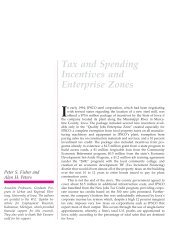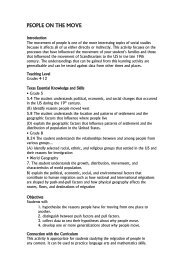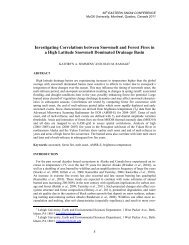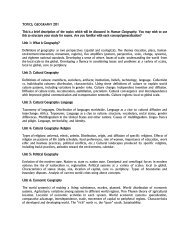Texas Social Studies Framework - Department of Geography ...
Texas Social Studies Framework - Department of Geography ...
Texas Social Studies Framework - Department of Geography ...
You also want an ePaper? Increase the reach of your titles
YUMPU automatically turns print PDFs into web optimized ePapers that Google loves.
72<br />
72<br />
• The third step is for teachers to work with<br />
someone else in a follow-up activity to reinforce<br />
the new knowledge. This person might be a<br />
curriculum specialist, a trainer, a technical<br />
specialist, or a colleague with expertise in a<br />
specific field. The purpose <strong>of</strong> this follow-up is to<br />
practice implementation with feedback and<br />
suggestions for adjustment.<br />
• Finally, the teacher works with students, applying<br />
the new information in a classroom setting<br />
and using appropriate assessment models to<br />
determine the effect and influence <strong>of</strong> the<br />
teacher’s new knowledge on students.<br />
Content is the “what” <strong>of</strong> staff development and refers to<br />
the skills and knowledge that effective educators need to<br />
possess or acquire. Teachers in <strong>Texas</strong> express a need for<br />
training in TEKS for <strong>Social</strong> <strong>Studies</strong> implementation.<br />
Other areas <strong>of</strong> content address issues such as recognizing<br />
and addressing the developmental needs <strong>of</strong> students,<br />
effectively managing the classroom environment,<br />
understanding diversity, thinking and learning, varying<br />
teaching strategies, and assessing performance. Further<br />
content <strong>of</strong> staff development is determined by needs<br />
identified in the following areas:<br />
• teachers’ knowledge and understanding <strong>of</strong><br />
subject matter and skills<br />
• operational methods <strong>of</strong> social scientists such as<br />
historians, geographers, economists, political<br />
scientists, anthropologists, and sociologists<br />
• district and campus goals<br />
• specific interests and needs <strong>of</strong> students<br />
• current research about teaching and learning<br />
social studies<br />
• reading strategies<br />
• the writing process<br />
• math tools used for social studies content<br />
• science as it relates to social studies processes<br />
and content<br />
• fine arts and cultural concepts<br />
• technology as a tool for teaching and learning<br />
social studies<br />
Determining the exact content <strong>of</strong> a given staff development<br />
experience emerges from a careful assessment <strong>of</strong><br />
the teacher’s pr<strong>of</strong>essional needs, the first step in the staff<br />
development process.<br />
Attention to all three categories <strong>of</strong> staff development,<br />
context, process, and content, is necessary for effective<br />
Chapter 7: Pr<strong>of</strong>essional Development in <strong>Social</strong> <strong>Studies</strong><br />
and quality staff development. The context defines the<br />
level <strong>of</strong> support for teachers in pursuit <strong>of</strong> their staff<br />
development goals and creates the boundaries for<br />
implementation <strong>of</strong> the process. Fully following the<br />
process ensures understanding and use <strong>of</strong> the content.<br />
Altogether, procedures that maximize positive and<br />
effective context, process, and content lead to the<br />
ultimate goal <strong>of</strong> staff development: providing powerful<br />
learning experiences that increase student success.<br />
EXAMPLES OF MODELS OF STAFF<br />
DEVELOPMENT IN SOCIAL STUDIES<br />
Effective staff developers rely on a variety <strong>of</strong> approaches.<br />
Five distinct models (Sparks and Loucks-Horsley, 1990)<br />
are described here, each <strong>of</strong> which contributes to an<br />
effective staff development program. An example<br />
relevant to pr<strong>of</strong>essional development in the social studies<br />
follows each model description.<br />
• Individually guided staff development: In this<br />
model the learner designs the learning activities.<br />
Teachers address their own problems through<br />
careful study and application.<br />
Example: An effective example <strong>of</strong> individually<br />
guided staff development is the <strong>Social</strong> <strong>Studies</strong><br />
Educator Recognition Program (SSERP),<br />
sponsored and conducted by the <strong>Texas</strong> Council<br />
for the <strong>Social</strong> <strong>Studies</strong> (TCSS) and supported by<br />
SSCED. Teachers participating in this program<br />
identify their staff development needs and then<br />
design their learning activities according to the<br />
elements defined in the SSERP. At the close <strong>of</strong><br />
the school year, teachers submit to TCSS a<br />
portfolio that describes their staff development<br />
and its effects on student learning. Teachers who<br />
meet SSERP standards will receive a distinguished<br />
performance award from TCSS.<br />
Teachers not participating in the SSERP process<br />
can design their own staff development and<br />
identify and use resources that will aid them in<br />
pr<strong>of</strong>essional growth. Such resources include<br />
journal articles, pr<strong>of</strong>essional videos, workshops<br />
and institutes, mentors, and university course<br />
work. Teachers can proceed individually or<br />
participate in study groups.
















